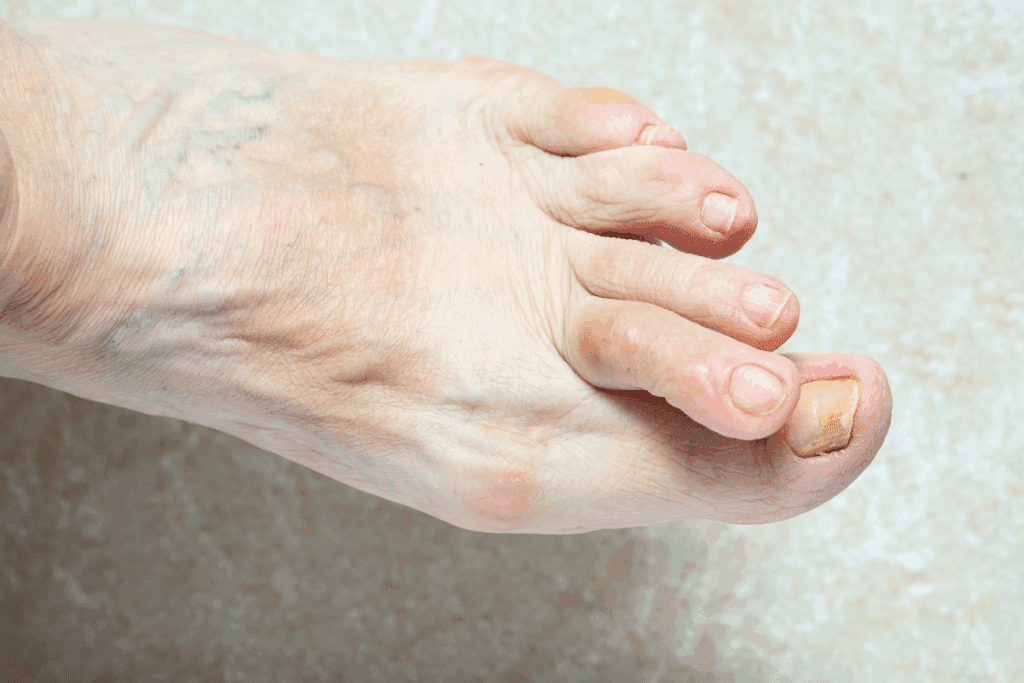Last Updated on November 4, 2025 by mcelik

Autoimmune diseases with psoriatic arthritis often share similar triggers and immune system pathways. Psoriatic arthritis (PsA) affects millions globally, causing both joint and skin inflammation. Up to 30% of people with psoriasis may develop PsA, making it a major concern for those with chronic skin conditions.
Understanding the link between autoimmune diseases with psoriatic arthritis helps doctors and patients manage symptoms more effectively. Discover the connections between PsA and other autoimmune disorders, and explore proven management strategies for long-term relief.

Autoimmune diseases, like psoriatic arthritis, happen when the body’s immune system attacks healthy cells by mistake. Psoriatic arthritis (PsA) is a long-term condition that combines the swollen, scaly skin of psoriasis with joint inflammation. This mix of immune system issues and body tissue damage causes PsA’s symptoms.
The immune system’s wrong response is key to PsA. Normally, it fights off germs. But in PsA, it attacks the body’s own cells, causing inflammation and damage in joints and skin. The immune system’s role is vital in understanding the disease’s progression and symptoms.
PsA affects both the skin and joints. It can cause a wide range of symptoms, from mild to severe.
Joint symptoms in PsA vary among patients. Common patterns include:
Skin symptoms are a key feature of PsA, with psoriasis being the most common. The severity of skin symptoms can match the severity of joint symptoms.
| Symptom | Description | Prevalence |
| Joint Pain and Swelling | Inflammation causes pain and swelling in the joints | Common |
| Skin Plaques | Red, scaly patches on the skin, often on elbows, knees, or scalp | Very Common |
| Nail Changes | Pitting, thickening, or separation of the nail from the nail bed | Frequent |
Knowing these features is key to diagnosing and managing PsA well. A treatment plan that covers both joint and skin symptoms is needed.

Autoimmune diseases often cluster together, as seen in psoriatic arthritis patients. This is not just a coincidence. It’s because these diseases share genetic and inflammatory pathways.
Autoimmune clustering means that people can have more than one autoimmune disease. For those with psoriatic arthritis, this risk is higher. They might also develop other autoimmune conditions.
Studies show that people with psoriatic arthritis are more likely to have other autoimmune diseases. A study found that common comorbidities include rheumatoid arthritis, lupus, and Hashimoto’s thyroiditis.
| Comorbid Condition | Prevalence in PsA Patients |
| Rheumatoid Arthritis | 15% |
| Lupus | 5% |
| Hashimoto’s Thyroiditis | 8% |
The shared inflammatory pathways are a key factor in the clustering of autoimmune diseases. Inflammatory cytokines play a big role in these conditions. A researcher noted, “The common inflammatory pathways provide a target for treating multiple autoimmune diseases at once.”
“The presence of one autoimmune disease should prompt a search for others, given their shared underlying mechanisms.”
The concept of autoimmune clustering shows the need for a complete treatment plan. This is for patients with psoriatic arthritis and other autoimmune conditions.
People with psoriasis often face a higher risk of other autoimmune diseases, mainly those affecting the skin. Psoriasis is a long-term condition marked by red skin patches with silvery scales.
Psoriatic arthritis (PsA) is closely tied to psoriasis. Many with PsA also deal with other skin autoimmune issues. This shows how different autoimmune conditions can be connected.
Those with psoriasis might also get other skin autoimmune diseases. Two common ones are vitiligo and alopecia areata.
Vitiligo causes white patches on the skin due to lost pigment-producing cells. It often happens with psoriasis, showing that both are autoimmune.
Alopecia areata leads to hair loss in patches, an autoimmune issue. It can also appear with psoriasis, showing how autoimmune diseases can cluster in some people.
It’s important to know the differences between rheumatoid arthritis (RA) and psoriatic arthritis (PsA). Both are autoimmune diseases that cause joint inflammation. But they have unique characteristics.
Diagnosing RA versus PsA can be tricky because their symptoms overlap. Both can cause joint pain, swelling, and stiffness. But PsA often comes with skin psoriasis, which RA does not.
The main differences between RA and PsA are in how they show up clinically:
Even though both conditions involve inflammation, their treatments have some similarities but also differences. Both RA and PsA may be treated with:
The choice of treatment can depend on whether PsA has skin involvement or RA has systemic symptoms.
In conclusion, while RA and PsA share some similarities, their unique features and treatments require a precise diagnosis. This is key to effective management.
To understand the link between ankylosing spondylitis and PsA, we must look at their similarities. Both are inflammatory spondyloarthropathies with chronic inflammation. They share many clinical features.
Ankylosing spondylitis mainly affects the spine, causing chronic pain and discomfort. PsA can also affect the spine, leading to spondylitis. This shared spinal involvement shows their connection within the spondyloarthropathies category.
Clinical Features:
HLA-B27 is a key genetic factor in ankylosing spondylitis, found in most patients. PsA patients are less likely to have HLA-B27, but they share other genetic factors. These factors increase the risk of both diseases.
“The genetic predisposition to spondyloarthropathies, including ankylosing spondylitis and PsA, highlights the role of genetic screening and family history in diagnosis.”
Distinguishing between ankylosing spondylitis and PsA can be tough due to similar symptoms. Treatment often includes medications to reduce inflammation and manage symptoms.
| Condition | Primary Features | Treatment Approaches |
| Ankylosing Spondylitis | Spinal inflammation, chronic pain | NSAIDs, TNF inhibitors |
| Psoriatic Arthritis | Joint inflammation, skin psoriasis | DMARDs, biologics |
The connection between psoriatic arthritis and inflammatory bowel diseases is complex. People with psoriatic arthritis are more likely to get Crohn’s or ulcerative colitis. This suggests a shared inflammatory pathway.
Research is exploring the link between gut and joint inflammation. It shows that IBD inflammation might lead to joint inflammation in PsA. This points to a widespread inflammatory process.
Gut-joint axis is the connection between the gut and joints. In PsA, an imbalance in gut bacteria may worsen both IBD and PsA symptoms.
Studies show IBD is more common in PsA patients than in the general public. This suggests common factors or an increased risk of one condition with the other.
A study found that patients with PsA are more likely to develop Crohn’s disease or ulcerative colitis. This highlights the need for doctors to watch for this comorbidity in PsA patients.
Dealing with PsA and IBD together needs a full approach. Treatments aim to reduce inflammation in both joints and the gut. This often involves a mix of medications.
Understanding the link between PsA and IBD helps healthcare providers offer better care. This improves outcomes for those with these complex conditions.
It’s important to know how psoriatic arthritis (PsA) and other autoimmune diseases work together. Diseases like lupus and Sjögren’s syndrome can happen with PsA. This makes treating patients more complex.
Lupus and PsA together can be tough to handle. They share symptoms, which can make the disease worse. A detailed treatment plan is needed for these patients.
Telling lupus and PsA apart can be hard because they have similar signs. But there are clues. Lupus often has a malar rash and affects the kidneys. PsA is known for joint pain, skin psoriasis, and enthesitis.
| Condition | Common Symptoms | Distinctive Features |
| Lupus | Joint pain, fatigue, skin rashes | Malar rash, oral ulcers, and kidney involvement |
| Psoriatic Arthritis | Joint inflammation, skin psoriasis, enthesitis | Nail changes, dactylitis, axial involvement |
Treating lupus and PsA together needs a team effort. Doctors use a mix of drugs and lifestyle changes. Choosing the right treatment is key to helping both conditions.
Sjögren’s syndrome can also be associated with PsA. It causes dry eyes and mouth. This adds to the challenge of treating patients.
PsA and multiple sclerosis (MS) are not talked about much together. But they share autoimmune traits. This affects how they are treated.
In summary, PsA and other autoimmune diseases need a careful and team-based approach. This ensures the best care for patients.
PsA can raise the risk of other autoimmune diseases, like those affecting the endocrine system. These disorders happen when the immune system attacks the endocrine glands. This disrupts hormone production.
Hashimoto’s thyroiditis is an autoimmune disease that harms the thyroid gland, causing hypothyroidism. Studies show that people with PsA are more likely to have Hashimoto’s thyroiditis. This connection shows why it’s key to check thyroid function in PsA patients.
A study in the Journal of Autoimmune Diseases found a link between PsA and Hashimoto’s thyroiditis. This highlights the need for doctors to watch for this condition in their patients.
“The coexistence of PsA and Hashimoto’s thyroiditis in some patients suggests a complex interplay between autoimmune diseases, necessitating a holistic approach to patient care.”
Type 1 diabetes is another endocrine autoimmune disorder linked to PsA. The inflammation shared by PsA and type 1 diabetes may increase the risk of type 1 diabetes in PsA patients. It’s important to watch for signs of pancreatic autoimmunity in PsA patients.
| Condition | Autoimmune Mechanism | Clinical Implications |
| PsA | The immune system attacks joints and skin | Joint inflammation, skin lesions |
| Type 1 Diabetes | Autoimmune destruction of pancreatic beta cells | Insulin deficiency, hyperglycemia |
| Hashimoto’s Thyroiditis | The immune system attacks the thyroid gland | Hypothyroidism, thyroid gland inflammation |
Autoimmune diseases of the adrenal and pituitary glands can also affect PsA patients. These conditions can cause hormonal imbalances, making PsA harder to manage. Knowing about these conditions is key to giving full care.
Diagnosing and managing multiple autoimmune conditions needs a detailed plan. When patients have more than one autoimmune disease, doctors face a big challenge. They must find the best way to care for them.
Testing for overlapping autoimmune diseases is key. Doctors use clinical checks, lab tests, and imaging to find the right answers. Comprehensive testing approaches help doctors see the whole picture of a patient’s health.
Lab tests might include blood counts and tests for specific antibodies. Imaging, like X-rays or MRI, helps check for damage. These tools help doctors get a clear view of what’s going on.
Managing multiple autoimmune conditions needs a team effort. Coordinated care means all doctors work together. This team might include rheumatologists, dermatologists, and gastroenterologists.
Good communication among doctors is vital. It prevents mistakes and makes sure all parts of the patient’s health are treated. This teamwork leads to better care and a better life for patients.
Treating multiple autoimmune diseases needs a deep understanding of each condition. Doctors must tailor treatments to each patient. They consider how each condition affects the others and how treatments might interact.
Biologics and DMARDs are key treatments for autoimmune diseases. They help control inflammation and slow disease progression. But doctors must use them carefully when treating multiple conditions.
Corticosteroids and anti-inflammatory drugs help with flares and inflammation. But using them for a long time can have side effects. Doctors watch for these closely.
New treatments for autoimmune diseases are being researched. These include new biologics and targeted therapies. They might offer better care for patients with multiple conditions.
In summary, treating multiple autoimmune conditions needs a detailed and team-based approach. By understanding these conditions and using various treatments, doctors can improve patient care and life quality.
Living with multiple autoimmune diseases needs a full care plan. This includes lifestyle changes and treatment plans. It’s important to understand how these conditions work together.
Genetics is a big part of autoimmune diseases. Knowing your genetic risk can help catch diseases early. Lifestyle choices like diet, stress, and exercise also affect your condition.
Managing multiple autoimmune diseases requires a team effort. A healthy lifestyle and sticking to treatment plans can help. This way, people can live better with these diseases, even though they’re challenging.
Psoriatic arthritis often goes hand in hand with other autoimmune diseases. This includes rheumatoid arthritis, ankylosing spondylitis, and inflammatory bowel disease. Lupus and multiple sclerosis are also common.
In psoriatic arthritis, the immune system mistakenly attacks healthy tissues. This leads to inflammation and symptoms in the joints and skin. It’s a result of an abnormal immune response, typical of autoimmune diseases.
Autoimmune clustering means that people with one autoimmune disease are more likely to have others. Psoriatic arthritis often falls into this category. Patients with it are more likely to develop other autoimmune conditions.
Yes, psoriasis and psoriatic arthritis can be linked to other skin conditions. This includes vitiligo and alopecia areata. These conditions share similar inflammatory pathways.
Both conditions involve joint inflammation, but they differ in severity and symptoms. Rheumatoid arthritis affects more joints and is symmetrical. Psoriatic arthritis affects fewer joints and often includes skin symptoms. Treatment varies based on the condition and its severity.
Ankylosing spondylitis and psoriatic arthritis share a common genetic link. Both often involve inflammation of the spine and other joints.
Inflammatory bowel disease, like Crohn’s and ulcerative colitis, is more common in those with psoriatic arthritis. This suggests a shared inflammatory pathway between the gut and joints.
Yes, it’s possible for systemic autoimmune diseases like lupus and multiple sclerosis to coexist with psoriatic arthritis. This requires careful diagnosis and management of symptoms and conditions.
People with psoriatic arthritis are at higher risk of endocrine autoimmune disorders. This includes Hashimoto’s thyroiditis, type 1 diabetes, and conditions affecting the adrenal and pituitary glands.
Diagnosing multiple autoimmune conditions requires a thorough testing approach. This involves various medical specialties. Treatment often includes a mix of medications and lifestyle changes tailored to each condition’s severity.
A healthy diet, regular exercise, stress management, and enough sleep can help manage symptoms. These changes improve overall well-being for those with multiple autoimmune diseases.
Subscribe to our e-newsletter to stay informed about the latest innovations in the world of health and exclusive offers!